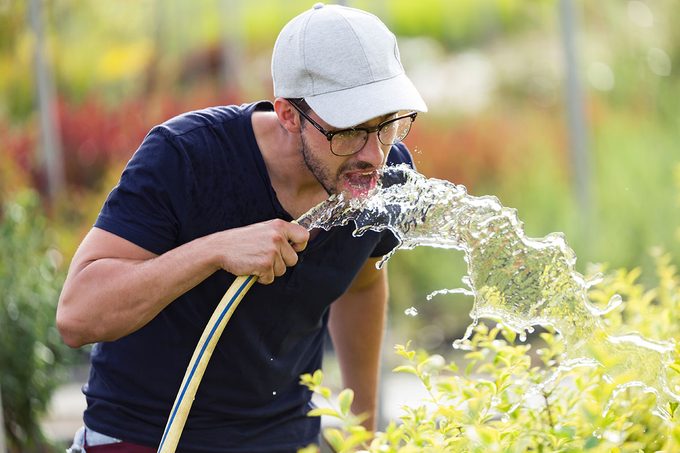Drinking from a garden hose may feel like a summer tradition, but it comes with risks homeowners should know.

Remember Drinking from the Hose as a Kid? Was It Really Safe?

When I was a kid, summer days were spent entirely outdoors. If we got thirsty, we’d take a quick drink from the garden hose and keep on playing. We never thought twice about it. But now, as a parent and homeowner, I find myself asking, “Is it actually safe to drink from the hose?” It turns out, the answer is no.
With summer just around the corner, it’s important to understand the risks of drinking from a garden hose to keep your family safe. While drinking from the hose might feel nostalgic, it’s best avoided by today’s kids so they can enjoy summer safely.
On This Page
Is the Water in My Sink the Same as the Water From the Hose?

In most homes, hose water and indoor tap water come from the same main water supply. That means the source is likely a municipal water system or a well, depending on where you live. So technically, the water coming from your bathroom faucet or outdoor spigot originates from the same place. However, the issue isn’t with the water, but with the different delivery methods at your home.
Any plumbing fixture that is meant to deliver potable, or drinking, water, must comply with safety standards set forth in the United States Environmental Protection Agency’s Safe Water Drinking Act (SWDA). This law created a “lead-free” standard for plumbing fixtures, fittings and pipes, ensuring these do not contain any lead that could leach into drinking water. However, non-potable fixtures, like shower valves, toilets and outdoor spigots (that connect to hoses) are exempt from SWDA regulations, so could contain lead.
Garden hoses themselves are also not held to this law and can contain other harmful substances. “Many hoses can contain bacteria, phthalates, BPA and lead,” Dave Hokanson, assistant manager of the Drinking Water Protection Section at the Minnesota Department of Health says, none of which you want in your drinking water.
Is It Safe to Drink Out of a Water Hose?
“Drinking from a hose is not generally recommended or considered to be safe,” Hokanson says. Here’s why:
- Chemical leaching: Standard hoses may contain lead and other chemicals that can leach into the water, especially when the hose is warm or sitting in the sun. The Ecology Center in Ann Arbor, Michigan, conducted a study of garden hoses sold at large home centers and found high levels of lead, bromine, antimony and phthalates. The same chemicals also leached into the water from these hoses.
- Bacterial growth: Stagnant water left in hoses is a breeding ground for bacteria and mold, especially when left in the sun.
- Contaminated connections: Outdoor faucets and hose fittings can be exposed to dirt, insects and lawn chemicals, which can end up in the water. These can also contain lead that can leach into the water.
What can you do instead?
If you want safe outdoor drinking water, look for hoses labeled “drinking water safe” or “lead-free.” These are often made of polyurethane or rubber and meet National Sanitation Foundation (NSF) safety standards. They’re commonly used for RVs and boats, but work just as well in your yard. The Ecology Center report found that these types of hoses and their water samples did not contain harmful chemicals or elements.
About the Expert
- Dave Hokanson is the assistant manager of the Drinking Water Protection Section at the Minnesota Department of Health.
Sources
- United States Environmental Protection Agency “Use of Lead Free Pipes, Fittings, Fixtures, Solder and Flux for Drinking Water” (2024)
- Environmental Resource Center “Read This Before You Drink From That Garden Hose” (2016)
RELATED:




















